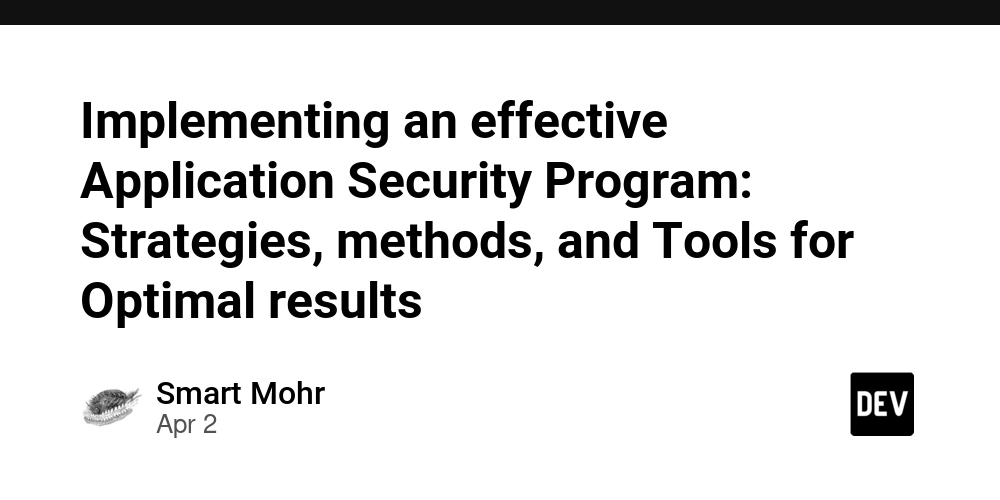Implementing an effective Application Security Program: Strategies, methods, and Tools for Optimal results
AppSec is a multifaceted, robust approach that goes beyond vulnerability scanning and remediation. The constantly evolving threat landscape, and the rapid pace of development and the growing complexity of software architectures requires a holistic and proactive approach that seamlessly incorporates security into every stage of the development process. This comprehensive guide explains the most important components, best practices and the latest technologies that make up an extremely effective AppSec program that empowers organizations to fortify their software assets, mitigate risk, and create an environment of security-first development. At the heart of the success of an AppSec program lies a fundamental shift in mindset which sees security as an integral aspect of the development process rather than an afterthought or a separate undertaking. This paradigm shift requires close collaboration between security personnel as well as developers and operations personnel, removing silos and instilling a conviction for the security of the software they create, deploy and maintain. By embracing a DevSecOps method, organizations can integrate security into the structure of their development workflows to ensure that security considerations are taken into consideration from the very first stages of ideation and design all the way to deployment as well as ongoing maintenance. This method of collaboration relies on the creation of security guidelines and standards, which provide a framework to secure code, threat modeling, and vulnerability management. These guidelines should be based on industry best practices, such as the OWASP Top Ten, NIST guidelines and the CWE (Common Weakness Enumeration) and take into consideration the specific requirements and risk profiles of each organization's particular applications as well as the context of business. These policies can be written down and made accessible to all interested parties and organizations will be able to use a common, uniform security policy across their entire application portfolio. To make these policies operational and to make them applicable for developers, it's important to invest in thorough security education and training programs. The goal of these initiatives is to equip developers with knowledge and skills necessary to write secure code, spot possible vulnerabilities, and implement best practices in security throughout the development process. The training should cover a variety of topics, including secure coding and common attacks, as well as threat modeling and safe architectural design principles. The best organizations can lay a strong base for AppSec through fostering a culture that encourages continuous learning, and by providing developers the tools and resources that they need to incorporate security into their daily work. In addition to training organizations should also set up secure security testing and verification processes to identify and address vulnerabilities before they can be exploited by criminals. agentic ai in appsec This requires a multi-layered approach, which includes static and dynamic analysis techniques as well as manual code reviews and penetration testing. Static Application Security Testing (SAST) tools can be used to analyse the source code and discover possible vulnerabilities, like SQL injection, cross-site scripting (XSS) as well as buffer overflows in the early stages of the process of development. Dynamic Application Security Testing (DAST) tools, on the other hand can be utilized to simulate attacks against running applications, while detecting vulnerabilities that are not detectable by static analysis alone. Although these automated tools are crucial to detect potential vulnerabilities on a scale, they are not the only solution. Manual penetration testing conducted by security professionals is essential to uncovering complex business logic-related flaws that automated tools may fail to spot. Combining automated testing with manual validation, organizations can obtain a full understanding of their security posture. It also allows them to prioritize remediation efforts according to the magnitude and impact of the vulnerabilities. Enterprises must make use of modern technology, like artificial intelligence and machine learning to increase their capabilities in security testing and vulnerability assessments. AI-powered tools can analyze vast amounts of code and application data, identifying patterns and abnormalities that could signal security concerns. how to use ai in application security These tools can also learn from vulnerabilities in the past and attack techniques, continuously improving their ability to detect and stop emerging threats. One particular application that is highly promising for AI within AppSec is the use of code property graphs (CPGs) that can facilitate an accurate and more efficient vulnerability identification and remediation. CPGs offer a rich, symbolic representation of an applic

AppSec is a multifaceted, robust approach that goes beyond vulnerability scanning and remediation. The constantly evolving threat landscape, and the rapid pace of development and the growing complexity of software architectures requires a holistic and proactive approach that seamlessly incorporates security into every stage of the development process. This comprehensive guide explains the most important components, best practices and the latest technologies that make up an extremely effective AppSec program that empowers organizations to fortify their software assets, mitigate risk, and create an environment of security-first development.
At the heart of the success of an AppSec program lies a fundamental shift in mindset which sees security as an integral aspect of the development process rather than an afterthought or a separate undertaking. This paradigm shift requires close collaboration between security personnel as well as developers and operations personnel, removing silos and instilling a conviction for the security of the software they create, deploy and maintain. By embracing a DevSecOps method, organizations can integrate security into the structure of their development workflows to ensure that security considerations are taken into consideration from the very first stages of ideation and design all the way to deployment as well as ongoing maintenance.
This method of collaboration relies on the creation of security guidelines and standards, which provide a framework to secure code, threat modeling, and vulnerability management. These guidelines should be based on industry best practices, such as the OWASP Top Ten, NIST guidelines and the CWE (Common Weakness Enumeration) and take into consideration the specific requirements and risk profiles of each organization's particular applications as well as the context of business. These policies can be written down and made accessible to all interested parties and organizations will be able to use a common, uniform security policy across their entire application portfolio.
To make these policies operational and to make them applicable for developers, it's important to invest in thorough security education and training programs. The goal of these initiatives is to equip developers with knowledge and skills necessary to write secure code, spot possible vulnerabilities, and implement best practices in security throughout the development process. The training should cover a variety of topics, including secure coding and common attacks, as well as threat modeling and safe architectural design principles. The best organizations can lay a strong base for AppSec through fostering a culture that encourages continuous learning, and by providing developers the tools and resources that they need to incorporate security into their daily work.
In addition to training organizations should also set up secure security testing and verification processes to identify and address vulnerabilities before they can be exploited by criminals. agentic ai in appsec This requires a multi-layered approach, which includes static and dynamic analysis techniques as well as manual code reviews and penetration testing. Static Application Security Testing (SAST) tools can be used to analyse the source code and discover possible vulnerabilities, like SQL injection, cross-site scripting (XSS) as well as buffer overflows in the early stages of the process of development. Dynamic Application Security Testing (DAST) tools, on the other hand can be utilized to simulate attacks against running applications, while detecting vulnerabilities that are not detectable by static analysis alone.
Although these automated tools are crucial to detect potential vulnerabilities on a scale, they are not the only solution. Manual penetration testing conducted by security professionals is essential to uncovering complex business logic-related flaws that automated tools may fail to spot. Combining automated testing with manual validation, organizations can obtain a full understanding of their security posture. It also allows them to prioritize remediation efforts according to the magnitude and impact of the vulnerabilities.
Enterprises must make use of modern technology, like artificial intelligence and machine learning to increase their capabilities in security testing and vulnerability assessments. AI-powered tools can analyze vast amounts of code and application data, identifying patterns and abnormalities that could signal security concerns. how to use ai in application security These tools can also learn from vulnerabilities in the past and attack techniques, continuously improving their ability to detect and stop emerging threats.
One particular application that is highly promising for AI within AppSec is the use of code property graphs (CPGs) that can facilitate an accurate and more efficient vulnerability identification and remediation. CPGs offer a rich, symbolic representation of an application's codebase. appsec with AI They can capture not just the syntactic architecture of the code, but as well as the complicated interactions and dependencies that exist between the various components. Through the use of CPGs AI-driven tools, they can conduct a deep, contextual analysis of an application's security position, identifying vulnerabilities that may be missed by traditional static analysis techniques.
Moreover, CPGs can enable automated vulnerability remediation by making use of AI-powered code transformation and repair techniques. By understanding the semantic structure of the code as well as the characteristics of the vulnerabilities, AI algorithms can generate targeted, context-specific fixes that address the root cause of the problem instead of just treating the symptoms. This method not only speeds up the process of remediation, but also minimizes the chance of breaking functionality or creating new vulnerability.
Integrating security testing and validating into the continuous integration/continuous deployment (CI/CD) pipeline is a key component of a successful AppSec. Automating security checks and integrating them into the build-and-deployment process allows organizations to spot vulnerabilities earlier and block the spread of vulnerabilities to production environments. This shift-left approach to security allows for more efficient feedback loops, which reduces the time and effort required to identify and remediate issues.
To achieve the level of integration required enterprises must invest in most appropriate tools and infrastructure to enable their AppSec program. This does not only include the security testing tools but also the underlying platforms and frameworks that allow seamless integration and automation. Containerization technologies like Docker and Kubernetes are able to play an important part in this, creating a reliable, consistent environment for running security tests while also separating the components that could be vulnerable.
Effective tools for collaboration and communication are just as important as a technical tool for establishing an environment of safety, and helping teams work efficiently together. Jira and GitLab are problem tracking systems that can help teams manage and prioritize security vulnerabilities. Chat and messaging tools like Slack and Microsoft Teams facilitate real-time knowledge sharing and communications between security experts.
The performance of any AppSec program isn't just dependent on the technologies and tools used however, it is also dependent on the people who are behind it. To create a secure and strong culture requires leadership commitment as well as clear communication and the commitment to continual improvement. Through fostering a sense shared responsibility for security, encouraging dialogue and collaboration, as well as providing the necessary resources and support to create an environment where security is not just a box to check, but an integral element of the process of development.
To ensure the longevity of their AppSec program, organizations must also focus on establishing meaningful measures and key performance indicators (KPIs) to measure their progress and pinpoint areas of improvement. These measures should encompass the entire life cycle of an application, from the number and nature of vulnerabilities identified during the development phase to the time required to fix issues to the overall security level. These metrics can be used to demonstrate the benefits of AppSec investment, spot trends and patterns, and help organizations make decision-based decisions based on data about where they should focus their efforts.
To stay on top of the ever-changing threat landscape, as well as emerging best practices, businesses should be engaged in ongoing learning and education. This could include attending industry conferences, taking part in online courses for training and collaborating with security experts from outside and researchers in order to stay abreast of the most recent trends and techniques. Through the cultivation of a constant learning culture, organizations can ensure that their AppSec applications are able to adapt and remain capable of coping with new threats and challenges.
It is also crucial to recognize that application security is not a once-in-a-lifetime endeavor but an ongoing process that requires constant commitment and investment. As new technologies are developed and practices for development evolve organisations must continuously review and review their AppSec strategies to ensure they remain efficient and aligned with their business goals. If they adopt a stance that is constantly improving, encouraging cooperation and collaboration, as well as leveraging the power of new technologies like AI and CPGs, organizations can build a robust, flexible AppSec program that does not just protect their software assets but also lets them develop with confidence in an increasingly complex and challenging digital landscape.agentic ai in appsec













































































































































































![[The AI Show Episode 142]: ChatGPT’s New Image Generator, Studio Ghibli Craze and Backlash, Gemini 2.5, OpenAI Academy, 4o Updates, Vibe Marketing & xAI Acquires X](https://www.marketingaiinstitute.com/hubfs/ep%20142%20cover.png)































































































































![[DEALS] Microsoft Office Professional 2021 for Windows: Lifetime License (75% off) & Other Deals Up To 98% Off – Offers End Soon!](https://www.javacodegeeks.com/wp-content/uploads/2012/12/jcg-logo.jpg)













































































































































_Anthony_Brown_Alamy.jpg?#)
_Hanna_Kuprevich_Alamy.jpg?#)




.png?#)

























































































![Hands-on: We got to play Nintendo Switch 2 for nearly six hours yesterday [Video]](https://i0.wp.com/9to5toys.com/wp-content/uploads/sites/5/2025/04/Switch-FI-.jpg.jpg?resize=1200%2C628&ssl=1)
![Fitbit redesigns Water stats and logging on Android, iOS [U]](https://i0.wp.com/9to5google.com/wp-content/uploads/sites/4/2023/03/fitbit-logo-2.jpg?resize=1200%2C628&quality=82&strip=all&ssl=1)














![YouTube Announces New Creation Tools for Shorts [Video]](https://www.iclarified.com/images/news/96923/96923/96923-640.jpg)

![Apple Faces New Tariffs but Has Options to Soften the Blow [Kuo]](https://www.iclarified.com/images/news/96921/96921/96921-640.jpg)




































































































































